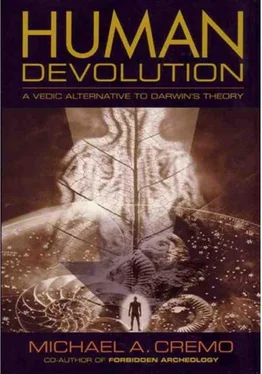Michael Cremo - Human Devolution - A Vedic Alternative To Darwin's Theory
Здесь есть возможность читать онлайн «Michael Cremo - Human Devolution - A Vedic Alternative To Darwin's Theory» весь текст электронной книги совершенно бесплатно (целиком полную версию без сокращений). В некоторых случаях можно слушать аудио, скачать через торрент в формате fb2 и присутствует краткое содержание. Год выпуска: 2003, ISBN: 2003, Издательство: Torchlight Publishing, Жанр: Старинная литература, на английском языке. Описание произведения, (предисловие) а так же отзывы посетителей доступны на портале библиотеки ЛибКат.
- Название:Human Devolution: A Vedic Alternative To Darwin's Theory
- Автор:
- Издательство:Torchlight Publishing
- Жанр:
- Год:2003
- ISBN:9780892133345
- Рейтинг книги:4 / 5. Голосов: 1
-
Избранное:Добавить в избранное
- Отзывы:
-
Ваша оценка:
- 80
- 1
- 2
- 3
- 4
- 5
Human Devolution: A Vedic Alternative To Darwin's Theory: краткое содержание, описание и аннотация
Предлагаем к чтению аннотацию, описание, краткое содержание или предисловие (зависит от того, что написал сам автор книги «Human Devolution: A Vedic Alternative To Darwin's Theory»). Если вы не нашли необходимую информацию о книге — напишите в комментариях, мы постараемся отыскать её.
Human Devolution: A Vedic Alternative To Darwin's Theory — читать онлайн бесплатно полную книгу (весь текст) целиком
Ниже представлен текст книги, разбитый по страницам. Система сохранения места последней прочитанной страницы, позволяет с удобством читать онлайн бесплатно книгу «Human Devolution: A Vedic Alternative To Darwin's Theory», без необходимости каждый раз заново искать на чём Вы остановились. Поставьте закладку, и сможете в любой момент перейти на страницу, на которой закончили чтение.
Интервал:
Закладка:
Humans and neandertals
As we have seen, one group of scientists says that modern human beings evolved from the ape man Homo erectus in various parts of the world, passing through a Neandertal or Neandertal-like stage. According to this view, called the multiregional hypothesis, today’s Asian people came from Asian Homo erectus, passing through a Neandertal-like stage. Similarly, today’s Europeans should be descendants of the classic Western European Neandertals.
Some scientists have compared the DNA of humans and Neandertals, seeking to clarify their evolutionary relationship. The evidence is inconclusive and subject to varying interpretations. Scientists led by Matthias Krings (1997) extracted some DNA from one of the bones of the original Neandertal specimen, discovered in Germany during the nineteenth century. The DNA was carefully analyzed to make sure it was from the bone itself, and not from modern human contamination. The DNA was mitochondrial DNA, which is passed down directly from mother to child.
Researchers compared the fragment of Neandertal mitochondrial DNA with mitochondrial DNA from 1600 modern humans from Europe, Africa, Asia, the Americas, Australia, and Oceania. The fragment of Neandertal mitochondrial DNA used in the comparison was composed of 327 nucleotide bases. Similar stretches of the modern human mitochondrial DNA samples differed from the Neandertal mitochondrial DNA sample by an average of 27 out of 327 nucleotide bases. The 1600 modern humans differed from each other by an average of 8 nucleotide bases out of 327. Chimpanzees differed from modern humans by 55 out of 327 nucleotide bases. Scientists took all this to mean that Neandertals are not closely related to modern humans. If they had been closely related to humans, the differences in nucleotide bases between humans and Neandertals should have been just slightly more than the average difference among humans—perhaps 10 or 12 nucleotide bases.
The scientists who looked at the DNA from the original Neandertal bones found it was no closer to today’s Europeans than to any other group of modern humans. They took this as contrary to the theory that the modern European populations evolved from the European Neandertals. According to this line of reasoning, the Neandertal DNA evidence favors the “out of Africa” hypothesis, which says that modern humans arose only once in Africa, about 100,000 years ago, and then spread to Europe and Asia, replacing the Neandertal-type hominids without breeding with them in any significant numbers. However, the researchers said about their mitochondrial DNA evidence: “These results do not rule out the possibility that Neandertals contributed other genes to modern humans” (Krings et al. 1997, p. 27).
The group of Neandertal DNA researchers headed by Krings proposed an age for the split between the Neandertals and the line of hominids that led to modern humans.They assumed that the human and chimp lines split at four or five million years ago, a figure based on rates of mutation in mitochondrial DNA. Using this as a starting point, they estimated the human/Neandertal split took place betweeen 550,000 and 690,000 years ago. But they acknowledged the possibility of “errors of unknown magnitude” (Krings et al. 1997, p. 25). In other words, the date is speculative. Furthermore, it is based on the assumption that there is an evolutionary connection between humans, chimps, Neandertals, etc., and that the relations reflected in their DNA are also relations of biological descent. But this is simply an assumption.
After the work done by Krings and his coworkers, William Goodwin, a geneticist at the University of Glasgow in Scotland, sequenced some mitochondrial DNA from the bones of an infant Neandertal discovered in the Mezmaikaya Cave, in the northern Caucusus Mountains (Bower 2000b). The bones are thought to be 29,000 years old. Goodwin compared the mitochondrial DNA from the Caucasus Neandertal infant to the mitochondrial DNA from the original German Neandertal (Krings et al. 1997). He found about the same amount of difference between them as between samples of mitochondrial DNA from modern humans. In other words, the two Neandertals were genetically close to each other. Furthermore, the mitochondrial DNA from the Caucasus Neandertal differed from modern humans by about the same amount as the German Neandertal, indicating that the Caucusus Neandertal, like the German one, was genetically distinct from modern humans. Goodwin said this supports the out of Africa replacement model of modern human origins. But Milford H. Wolpoff, a supporter of the multiregional modern human origins hypothesis, suggested that mitochondrial DNA from anatomically modern humans from the same time, 30,000 years ago, would differ from the mitochondrial DNA of today’s modern humans by the same amount as the Neandertal DNA. This could be tested by DNA from Homo sapiens living at that time, 30,000 years ago.
In the June 2000 issue of american Journal of Human Genetics, Lutz Bachmann and his colleagues at the Field Museum, Chicago, announced the results of studies of the nuclear DNA from two Neandertals and from anatomically modern Homo sapiens who existed 35,000 years ago. Using the DNA hybridization technique, which shows the degree of bonding between samples, they determined that the Homo sapiens DNA differed from the Neandertal DNA. This tends to support the work of Krings et al. and Goodwin. But anthropologist Erik Trinkaus disagreed. He pointed out that the DNA hybridization technique gives only a very crude measure of difference. He also said that there is a lot of subjectivity in judging what amount of difference in DNA amounts to a difference in species. Trinkaus believes that humans and Neandertals interbred (implying that their DNA was similar). However, he asserted that the genetic evidence for this interbreeding may have become diluted so much as to escape detection by crude DNA hybridization techniques (Bower 2000c).
New mitochondrial DNA studies have added a new element to the debate about the relationship between modern humans and the Neandertals. A team led by Gregory J. Adcock, of the Pierre and Marie Curie University in Paris, examined mitochondrial DNA samples from anatomically modern human skeletons, ranging from 2,000 years old to
62,000 years old. The mitochondrial DNA from the oldest skeleton, from Lake Mungo, Australia, turned out to be more different from that of living humans than the mitochondrial DNA of the Neandertals mentioned above (Bower 2001). Therefore, even if Neandertal DNA is quite different from modern human DNA, this does not necessarily mean that Neandertals did not interbreed with the anatomically modern humans.
Even so, the exact nature of the relationship between modern humans and Neandertals remains an open question. Perhaps humans and Neandertals are simply varieties of the same species. Perhaps they are different species, who interbred. If we ignore evolutionary speculations, the Neandertal DNA research simply shows that modern humans and Neandertals coexisted with each other. From the available genetic evidence, it is not possible to put any definite limit on how far back in time the coexistence actually goes. This is consistent with the views presented in Forbidden archeology, which posits the coexistence of anatomically modern humans and other distinct hominid types for vast periods of time.
Conclusion
Biochemical and genetic evidence is not as reliable as some would have us believe. Many researchers say that the fossil evidence is ultimately more important than the genetic evidence in answering questions about human origins and antiquity. As Frayer and his coauthors (1993, p. 19) said, “Unlike genetic data derived from living humans, fossils can be used to test predictions of theories about the past without relying on a long list of assumptions about the neutrality of genetic markers, mutational rates, or other requirements necessary to retrodict the past from current genetic variation . . . genetic information, at best, provides a theory of how modern human origins might have happened if the assumptions used in interpreting the genetic data are correct.” Contemplating the difficulties of using genetic evidence to establish theories of human origins and antiquity, Oxford University population geneticist Rosalind Harding said, “There’s no clear genetic test. We’re going to have to let the fossil people answer this one” (Gibbons 2001, p. 1052). And when we do look at the fossil evidence in its entirety, we find that anatomically modern humans go so far back in time that it becomes impossible to explain their presence on this planet by current Darwinian theories of evolution. Furthermore, when we look at human origins in terms of the larger question of the origin of life on earth, we find that modern science has not been able to tell us how the first living things, with their genetic systems, came into existence.
Читать дальшеИнтервал:
Закладка:
Похожие книги на «Human Devolution: A Vedic Alternative To Darwin's Theory»
Представляем Вашему вниманию похожие книги на «Human Devolution: A Vedic Alternative To Darwin's Theory» списком для выбора. Мы отобрали схожую по названию и смыслу литературу в надежде предоставить читателям больше вариантов отыскать новые, интересные, ещё непрочитанные произведения.
Обсуждение, отзывы о книге «Human Devolution: A Vedic Alternative To Darwin's Theory» и просто собственные мнения читателей. Оставьте ваши комментарии, напишите, что Вы думаете о произведении, его смысле или главных героях. Укажите что конкретно понравилось, а что нет, и почему Вы так считаете.












